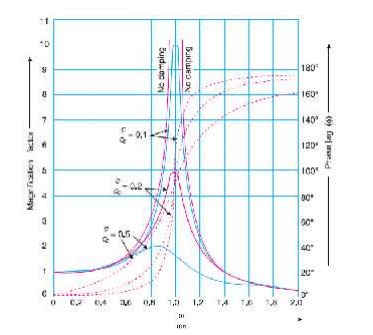Chapter: Mechanical : Dynamics of Machines : Forced Vibration
Important Short Questions and Answers: Forced Vibration
FORCED
VIBRATION
1. What
is meant by forced vibrations ? Give Examples of forced vibrations.
When the body vibrates under the influence of external force, then the
body is said to be under forced vibrations.
Examples:
• Ringing of electrical bell
• The vibrations of air compressors, internal combustion engines,
machine tools and various other machinery.
2. What
are the types of external excitation?
• Periodic forces
• Impulsive forces and
• Random forces.
3. What
is the vibration isolation?
The term vibration isolation refers to the prevention or minimization of
vibrations and their transmission due to the unbalanced machines.
4.
Specify the importance of vibration isolation?
When an unbalanced machine is installed on the foundation, it produces
vibration in the foundation. So, in order to prevent these vibrations or to
minimize the transmission of forces to the foundation, vibration isolation is
important.
5. When
does resonance takes place in a system?
When the frequency of external force is equal to the natural frequency
of a vibrating body, the resonance occurs. At resonance, the amplitude of
vibration becomes exclusively large.
6. Define
transmissibility?
When a machine is supported by a spring, the spring transmits the force
applied on the machine to the fixed support or foundation. This is called as
transmissibility.
7. What
is meant by harmonic forcing?
The term harmonic refers to a spring-mass system with viscous damping,
excited by a sinusoidal harmonic force.
F = F0sin ωt
8. Define
transmissibility ratio or isolation factor?
The ratio of force transmitted (FT) to the force applied (F)
is known as transmissibility ratio

9. What is the role of transmission ratio?
Transmission ratio, also known as transmissibility, is a measure of the effectiveness
of the vibration isolation material.
10. What
is meant by dyn amic magnifier or magnification factor? What are the factors on
which it dep end?
It is the ratio of max imum displacement of the forced vibration (Xma x)
to the deflection due to the sta tic force F (x0)

It depends on: (i) the ra tio of circular frequencies
(ii) The damping factor (z )
11.Write
down the expression for amplitude of forced vibration. ?
Amplitude of forced vibration,
12. List
out the materials u sed for vibration isolation. Laso which ma terial is most
suitable for compressiv e loads?
• Rubber
• Felt
• Cork
• Metallic Springs
Cork is suitable for compressive loads because it is not perfec tly
elastic. At high loads it becomes more flexible.
13. Show
that for effective isolation of vibration, frequency ratio r >√ 2.
When r >√2, the n transmissibility is less than one for all valu es
of damping factor. This means that the tran smitted force is always less than
the excited force.
14.
Sketch the graph for ( ω/ωn) Vs Transmissibility for different values of
damping factor.

15. What are the methods of
isolating the vibration?
• High
speed en gines/machines mounted on foundation a nd supports cause vibrations of
ex cessive amplitude because of the unbalance d forces. It can be minimized by
p roviding “spring-damper” , etc.
• The
materials u sed for vibration isolation are rubber, felt c ork, etc. These are
placed between the foundation and vibrating body.
TUTORIAL PROBLEMS:
1.
A machine of
mass 100 kg is supported on openings of total stiffness 800 kN/m and has a
rotating unbalanced element which results in a disturbing force of 400 N at a
speed of 3000 r.p.m. Assum-ing the damping ratio as 0.25, determine : 1. the
amplitude of vibrations due to unbalance ; and 2. the transmitted force. [Ans. 0.04mm
; 35.2 N]
2.
A mass of 500
kg is mounted on supports having a total stiffness of 100 kN/m and which
provides viscous damping, the damping ratio being 0.4. The mass is constrained
to move vertically and is subjected to a vertical disturbing force of the
type F
cos ω t. Determine the frequency at which
resonance will occur and the maximum allowable value of F if the amplitude at resonance is to be restricted to 5mm
[Ans. 2.25
Hz ; 400 N]
3.
A machine of
mass 75 kg is mounted on springs of stiffness 1200 kN/m and with an assumed
damping factor of 0.2. A piston within the machine of mass 2 kg has a
reciprocating motion with a stroke of 80 mm and a speed of 3000 cycles/min.
Assuming the motion to be simple harmonic, find : 1. the amplitude of motion of
the machine, 2. its phase angle with respect to the exciting force, 3. the
force transmitted to the foundation, and 4. the phase angle of transmitted
force with respect to the exciting force. [Ans.
1.254 mm ; 169.05° ; 2132 N ; 44.8°]
Related Topics